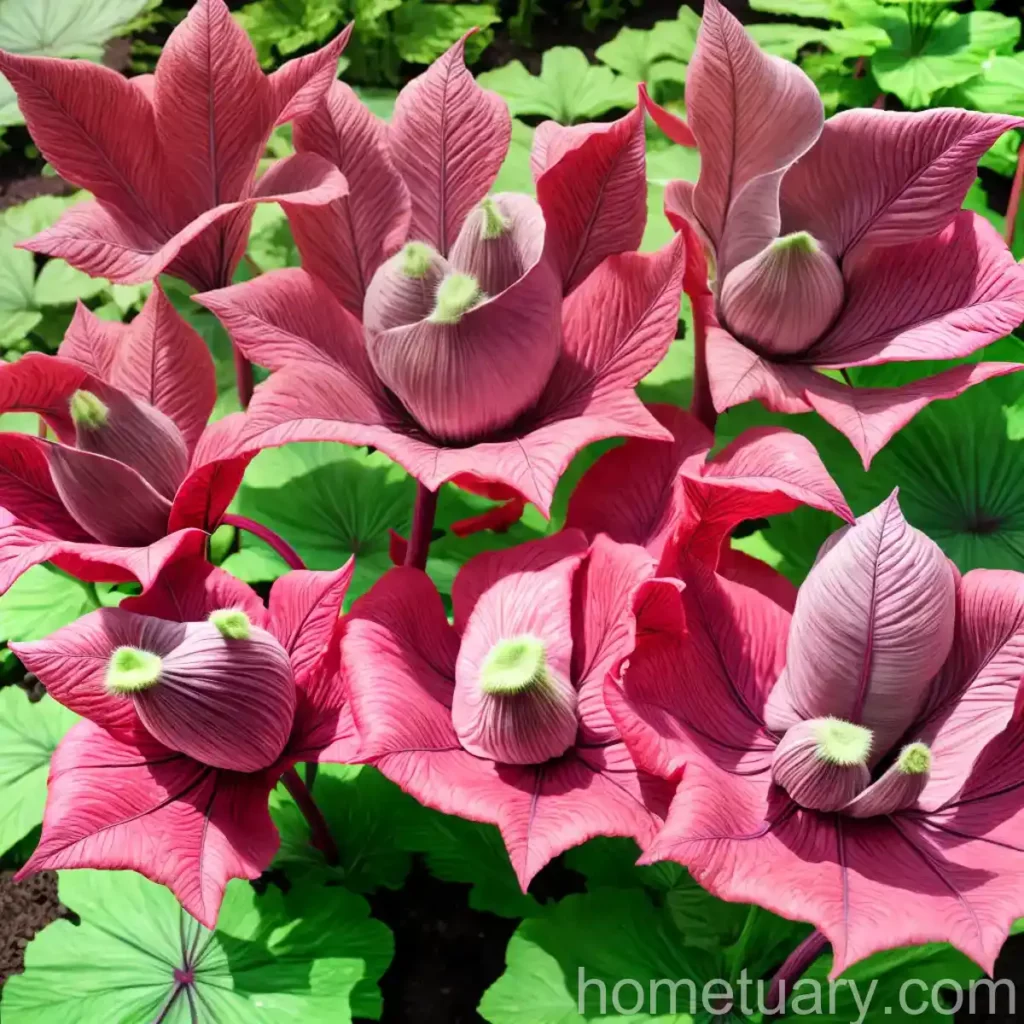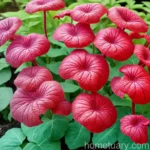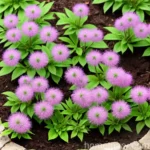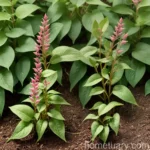The Wonderful World of Rhubarb (Rheum x hybridum)
Rhubarb, scientifically known as Rheum x hybridum, is a fascinating and versatile plant that has captured the interest of gardeners, chefs, and natural health enthusiasts alike. With its vibrant stalks and unique tart flavor, rhubarb has become a staple in many culinary traditions and has also found its place in traditional medicine and natural skincare. In this comprehensive guide, we will delve into the world of rhubarb, exploring its cultivation, uses, health benefits, and much more.
What is rhubarb (Rheum x hybridum)?
Rhubarb is a perennial plant that belongs to the family Polygonaceae. Although primarily grown for its edible stalks, the plant also exhibits ornamental qualities, making it a valuable addition to any garden. The most commonly cultivated species is Rheum x hybridum, which is a hybrid of Rheum rhabarbarum and Rheum rhaponticum. This robust and hardy plant is known for its large, vibrant green leaves and striking red or pink stalks.
Key Takeaways – rhubarb (Rheum x hybridum)
- Scientific Name: Rheum x hybridum
- Family: Polygonaceae
- Common Uses: Culinary purposes, ornamental garden accent
- Growth Habit: Perennial
- Flavor Profile: Tart and tangy
- Cultural Significance: Traditional medicine, natural dye, folklore and mythology
Now, let’s explore the various aspects of cultivating and caring for this remarkable plant.
Culture
Cultivating rhubarb is a rewarding experience, as it requires minimal maintenance and provides a bountiful harvest year after year. Understanding the cultural requirements of rhubarb is crucial for ensuring its healthy growth and productivity.
Uses
Culinary Purposes
One of the primary uses of rhubarb is for culinary purposes. The stalks of Rheum x hybridum are the edible part of the plant and are widely used in baking, cooking, and beverage preparation. From pies and tarts to jams and sauces, rhubarb adds a unique and delightful flavor to a wide range of dishes. It is particularly prized for its ability to impart a tangy taste, balancing out the sweetness in various recipes.
Ornamental Garden Accent
In addition to its culinary uses, rhubarb also serves as an ornamental plant in garden landscapes. The large, lush leaves and colorful stalks make it an attractive feature in both traditional and contemporary gardens. Its robust growth habit and vibrant colors add a visual appeal to garden beds and borders.
Water
Rhubarb plants require adequate water to thrive, especially during the active growing season. While they are relatively drought-tolerant once established, consistent moisture is crucial for promoting healthy stalk development and overall plant vigor.
Watering Guidelines for Rhubarb:
- Provide regular, deep watering, especially during dry spells.
- Avoid waterlogged conditions, as excessive moisture can lead to root rot and other issues.
- Aim to keep the soil consistently moist but not waterlogged.
- Mulching around the base of the plants can help retain soil moisture and reduce the need for frequent watering.
Sunlight
Proper sunlight exposure is essential for the successful cultivation of rhubarb. As a sun-loving plant, rhubarb thrives in full to partial sun conditions, benefiting from direct sunlight for a significant portion of the day.
Sunlight Requirements for Rhubarb:
- Plant rhubarb in a location that receives at least 6-8 hours of sunlight daily.
- Ensure that the planting site is well-drained and receives adequate air circulation, especially in humid climates.
- In warmer regions, providing partial shade during the hottest part of the day can help protect the plants from excessive heat stress.
Fertilizer
Fertilizing rhubarb plants is essential for promoting robust growth and enhancing stalk production. By supplying the necessary nutrients, gardeners can ensure that their rhubarb plants reach their full potential and produce a bountiful harvest of flavorful stalks.
Fertilization Tips for Rhubarb:
- Timing: Apply fertilizer in early spring as new growth emerges, and once again in late spring or early summer.
- Type: Use a balanced, slow-release fertilizer or incorporate well-rotted compost into the soil around the plants.
- Application: Spread the fertilizer evenly around the base of the plants, avoiding direct contact with the stalks or foliage.
- Avoid Over-fertilization: Excessive nitrogen can result in lush foliage at the expense of stalk production, so it’s important to use fertilizers in moderation.
Soil
The right soil conditions are vital for the successful cultivation of rhubarb. This plant thrives in well-drained, fertile soil with a slightly acidic to neutral pH. Understanding the soil requirements and making necessary adjustments can greatly impact the overall health and productivity of rhubarb plants.
Ideal Soil Conditions for Rhubarb:
- Texture: Well-drained loamy soil with good fertility is optimal for rhubarb.
- pH Level: Aim for a slightly acidic to neutral soil pH in the range of 6.0 to 7.0.
- Soil Amendments: Incorporate organic matter such as compost or well-rotted manure into the soil to improve its structure and fertility.
- Soil Moisture: Avoid waterlogged conditions, as rhubarb is susceptible to root rot in excessively wet soil.
Pruning
Pruning plays a pivotal role in maintaining the health and vigor of rhubarb plants. By removing old, damaged, or diseased stalks and foliage, gardeners can promote new growth and prevent the spread of diseases and pests. Proper pruning also helps to rejuvenate the plants and maintain a tidy appearance in the garden.
Pruning Guidelines for Rhubarb:
- Removal of Flower Stalks: As rhubarb plants send up flower stalks, promptly remove them to redirect the plant’s energy into stalk production and foliage growth.
- Old Stalk Removal: Each year, remove the oldest and thickest stalks to make room for new, vigorous growth. Cut them off at the base.
- Pruning Diseased Stalks: If any stalks show signs of disease or pest damage, promptly prune and dispose of them to prevent spread.
Propagation
Rhubarb plants can be propagated through division, allowing gardeners to create new plants from established ones. Proper timing and technique are essential for successful rhubarb propagation, enabling gardeners to expand their rhubarb patch or share plants with others.
Propagation Methods for Rhubarb:
- Division: Divide established rhubarb crowns in early spring or late fall. Use a sharp, clean tool to separate the crowns, ensuring that each division has healthy buds and roots.
- Transplanting: Plant the divided crowns in prepared soil, ensuring that the buds are positioned at the soil surface and the roots are well-spread in the planting hole.
- Establishment: Keep the newly propagated plants well-watered and protect them from excessive heat or cold during the establishment period.
Container Popularity
The popularity of growing rhubarb in containers has increased significantly, especially among urban gardeners and those with limited outdoor space. Container cultivation offers the flexibility to grow rhubarb in various settings, including balconies, patios, and rooftop gardens.
Benefits of Growing Rhubarb in Containers:
- Space Utilization: Containers allow individuals with limited garden space to enjoy growing rhubarb and harvesting their own stalks.
- Portability: Containers can be moved to optimize sunlight exposure and protect the plants from extreme weather conditions.
- Aesthetic Appeal: Rhubarb plants in containers add a decorative element to outdoor living spaces and can be incorporated into container garden arrangements.
Container Common Diseases
While container cultivation offers numerous advantages, it is essential to be mindful of potential disease issues that can affect rhubarb plants in containers. Proper care and preventive measures can help mitigate these challenges and ensure the health and longevity of container-grown rhubarb.
Common Diseases in Container-Grown Rhubarb:
- Crown Rot: Excessive moisture or poorly-drained soil in containers can lead to crown rot, causing the plant to wilt and decline.
- Fungal Diseases: Containers with inadequate air circulation can be more susceptible to fungal infections, such as leaf spot and powdery mildew.
- Root Diseases: Overcrowded root systems and insufficient soil drainage in containers can lead to root diseases, affecting the overall health of the plants.
Disease Diagnosis
Diagnosing and addressing diseases in container-grown rhubarb requires careful observation and prompt action. Early detection and intervention are key to preventing the spread of diseases and minimizing their impact on the plants.
Steps for Disease Diagnosis in Container-Grown Rhubarb:
- Visual Inspection: Regularly inspect the plants for any signs of discoloration, wilting, or abnormal growth.
- Symptom Identification: Identify specific symptoms, such as spots on leaves, yellowing, or stunted growth, to narrow down potential diseases.
- Research and Consultation: Refer to reputable resources and seek guidance from local extension services or professional gardeners to accurately diagnose the issues.
- Treatment Plan: Once the disease is identified, implement appropriate treatment measures, which may include cultural practices, organic or synthetic treatments, and adjustments to growing conditions.
Common Pests
Rhubarb plants are relatively resistant to pests, but they can still be affected by certain insects and pests that target the foliage, stalks, or roots. Understanding the common pests and implementing proactive pest management strategies can help protect rhubarb plants from infestations and damage.
Common Pests Affecting Rhubarb:
- Aphids: These small, sap-sucking insects can colonize the undersides of leaves and cause distortion and yellowing of foliage.
- Leaf Miners: Larvae of leaf-mining insects tunnel through the leaves, leaving visible trails and affecting the plant’s ability to photosynthesize effectively.
- Slugs and Snails: These mollusks can feed on the tender leaves of young rhubarb plants, causing significant damage.
Botanist’s Tips
As a plant scientist with a deep appreciation for rhubarb, I have gathered a few essential tips for cultivating and enjoying this remarkable plant to its fullest potential.
Rhubarb Plant Care Tips
- Planting Depth: When planting rhubarb crowns, ensure that the buds are positioned at or just below the soil surface to promote healthy growth.
- Mulching: Apply a layer of organic mulch around the base of rhubarb plants to conserve soil moisture and suppress weed growth.
- Stalk Harvesting: Harvest rhubarb stalks by gently pulling and twisting them away from the plant rather than cutting, as this method is less traumatic for the plant.
- Renovation: Periodically divide and replant rhubarb crowns to rejuvenate older patches and maintain vigorous growth.
Fun Facts
- The large leaves of rhubarb contain oxalic acid, which gives them their sour taste and makes them unsuitable for consumption.
- Rhubarb has been used as a natural dye for centuries, producing various shades of red, pink, and coral.
- In folklore and mythology, rhubarb has been associated with healing properties, protection against evil spirits, and even love potions.
Links to External Resources
To further expand your knowledge and appreciation for rhubarb, consider exploring the following resources:
- Royal Horticultural Society – Growing Rhubarb
- United States Department of Agriculture – Rhubarb Production Guide
- University of Minnesota Extension – Rhubarb for Home Gardens
By leveraging these resources, you can gain valuable insights and practical tips for growing, harvesting, and utilizing rhubarb to its fullest potential.
In conclusion, the world of rhubarb (Rheum x hybridum) is rich with culinary, cultural, and horticultural significance. From its versatile uses in the kitchen to its intriguing history and folklore, rhubarb continues to captivate enthusiasts around the globe. Whether you are a seasoned gardener, an aspiring chef, or a natural health enthusiast, embracing the wonders of rhubarb can open doors to a world of culinary creativity, natural remedies, and garden beauty.
As you embark on your journey with rhubarb, may you revel in the vibrant hues, tantalizing flavors, and timeless traditions that make this plant a cherished and enduring favorite.
Keywords: Rhubarb plant, Rheum x hybridum, Growing rhubarb, Rhubarb care, Rhubarb varieties, Edible rhubarb, Rhubarb cultivation, Rhubarb harvesting, Rhubarb recipes, Rhubarb health benefits, Rhubarb gardening, Rhubarb plants for sale, Rhubarb plant care tips, Rhubarb plant diseases, Organic rhubarb gardening, Rhubarb plant propagation, Rhubarb for desserts, Rhubarb cooking ideas, Rhubarb companion plants, Rhubarb season, Best conditions for growing rhubarb, Rhubarb as a perennial plant, Rhubarb plant nutrition, Rhubarb medicinal uses, Rhubarb in traditional medicine, Rhubarb preservation methods, Rhubarb for pies and tarts, Rhubarb as a natural dye, Rhubarb plant symbolism, Rhubarb in folklore and mythology, Rhubarb as a source of vitamins and minerals, Rhubarb-inspired cocktails, Rhubarb gardening mistakes to avoid, Rhubarb as a bee-friendly plant, Rhubarb and its unique taste, Rhubarb in history, Rhubarb as a food ingredient, Rhubarb wine-making, Rhubarb garden design ideas, Rhubarb and heart health, Companion planting with rhubarb, Rhubarb as a shade-tolerant plant, Rhubarb in different cuisines, Rhubarb for natural skincare, Rhubarb and digestive health, Rhubarb for healthy weight management, Rhubarb as a vibrant garden accent, Rhubarb and culinary arts, Rhubarb and its culinary versatility, Rhubarb-inspired home remedies















